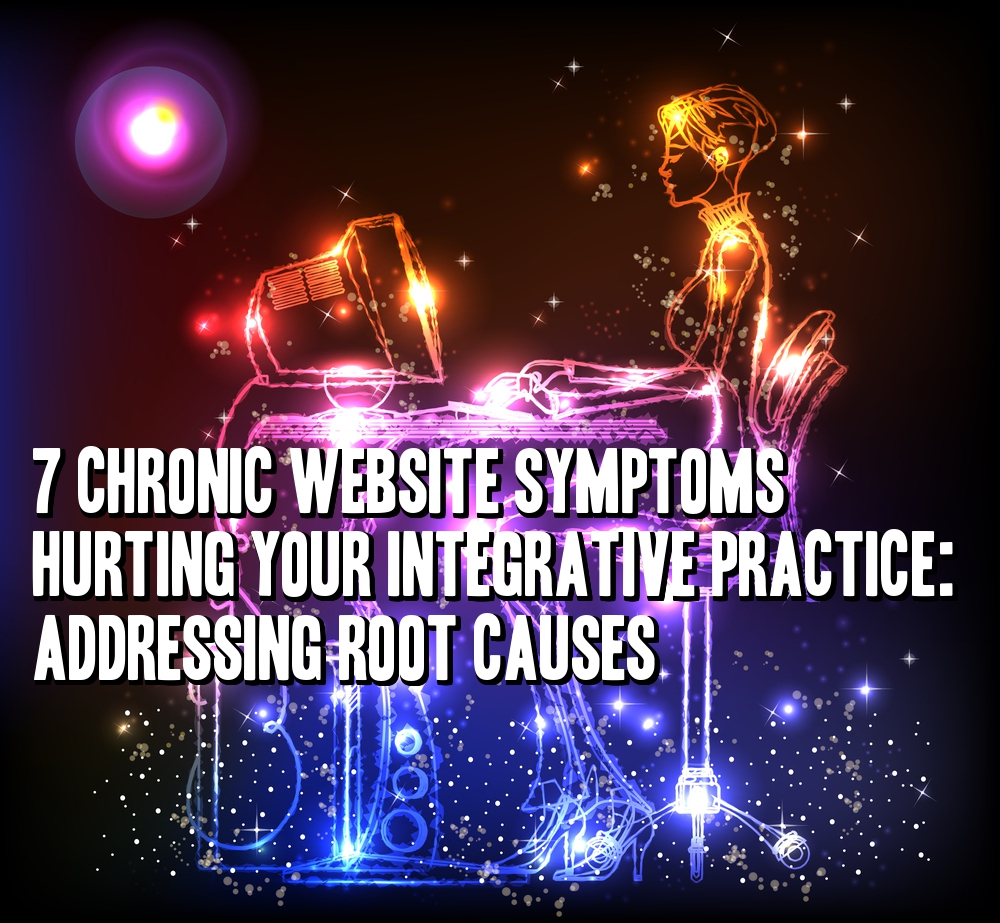7 Chronic Website Symptoms Hurting Your Integrative Practice: Addressing Root Causes
By Glenn Sabin

Today, over 85 percent of patients search online before booking a doctor’s appointment. If your website isn’t fully optimized to drive patient volume, you are losing business.
Do you have an established practice with lots of word-of-mouth physician and patient referrals?
It’s a certainty these referred prospects will look at your website before committing to see you.
Have you opted-out of Medicare and operate a direct-pay practice?
All the more reason your brand must shine online. After all, you’re asking folks to pay more, out of network, for your integrative health services.
Your site conveys your brand promise and identity, and communicates your company ethos. If that message was created before 2011—not a typo—it’s unlikely you have a vibrant online presence designed to deliver new patients to your reception room.
How many of the following conditions does your website suffer from?
1. Bad Design
There are plenty of free do-it-yourself website platforms. If you’ve opted for one, or created your site on the cheap, using a lower-end programmer or designer, chances are your site is, well, abysmal.
Unless you are a seasoned WordPress or Squarespace design guru turned integrative health healer, your time and energy will be best spent delivering quality patient care—and working on the productive aspects of your practice. Leave your website development to top talent.
Today’s most effective sites are professionally designed, utilizing current best practices of modern design. These best practices include:
- Responsive design: Today’s sites must be viewable and navigable across all devices—laptops, desktops, smartphones, and tablets. Mobile devices are used for more than half of all web visits. Full width sites that have less clicks and more scrolling are in vogue because they are the most functional. Google currently penalizes sites not optimized for mobile by not sending them traffic.
- Simplification: Image carousels and sidebars are largely being eliminated to simplify navigation. Sites with a zillion ‘pages’ (not to be confused with posts) are dinosaurs.
- Brand identity: A professionally created logo (and company name) utilizing an appropriate color palette that informs your entire site design, look, and feel is paramount.
- Visual over textual: Images are exponentially more memorable than text. Think ‘illustration’ for key communication elements across your site (and all content efforts).
2. Poor Messaging
You have six seconds to capture a new visitor’s attention. During this fleeting period your site must communicate who you are and why someone should care.
Enjoying this article? Subscribe and get our latest, delivered straight to your inbox.
To gain and maintain the attention of your site’s visitors—and get them to take the next desired step—you need copy that sings.
Is your site in tune?
Communicating powerfully: fewer words, shorter sentences are key.
I write a lot: articles for this site, business writing for FON’s clients, and my first book. There are myriad types of writing and, from my perspective, tight copywriting is the absolute hardest.
Mark Twain famously said, “If I had more time, I would have written a shorter letter.”
Concise, engaging writing is an art form.
You know best how to serve patients and clients, fulfill your organization’s mission, vision, and guiding principles, and you express your unique brand positioning—how your practice differs from your closest competitors.
You are most likely too close to the trees to translate all your business’s institutional knowledge into powerful, engaging articles, and staccato copy, for your site. Hire a top copywriter or content strategist who understands your unique brand and the integrative health and medicine space.
3. Brand Niche Not Established
You may be generally positioned as an integrative psychiatrist or functional medicine pediatrician, but if you haven’t established a niche—say OCD or allergies—in which to develop expertise and reputation as a community thought leader, you have not adequately distinguished yourself, your business, or personal brand.
Your clinical toolkit may extend far beyond one particular condition or pathology. However, it’s best to become well-known for one subject to gain traction and build community. I call it the ‘less is more’ strategy, where ‘less’, over time, becomes ‘abundance’.
4. No Lead Capture or Solid Calls to Action
Even if your website follows best practices of modern web design, and communicates stunningly, if folks don’t know what step to take—after you capture their attention in six seconds—they will click away.
What do you want site visitors to do next? Click deeper into an article? Subscribe to your newsletter? Book an appointment? Purchase a product? Follow you on 37 social media platforms?
Well, sorry, you cannot get people to take all these actions; at least not at first. But you can choose a primary and secondary call to action to swiftly move visitors to additional steps. This requires consistent messaging, and the provision of reciprocity: something of value in exchange for a prospect toward further engagement.
Does your homepage ask for too much without offering any tangible reward in exchange for a visitor’s information?
An e-book on, say, ‘top natural products to aid in digestion’ can be a winning formula as a giveaway in exchange for an email (to release the content). That’s lead capture.
Your site may have the opposite problem: lacking specific calls to action altogether, or perhaps requests that are hard to find? A smart balance of calls to action must be achieved in order to win new prospects and move them through the sales funnel—speaking of which…
5. No Sales Funnel
If you’re missing calls to action, or aren’t ‘asking’ in the right way, and/or in the right places on your site, visitors will not enter your sales funnel.
No sales funnel = limited patient panel.
Prospective patients and clients might complete a form, call a number to book an appointment, or even book online, if that option is available. But the totality of these actions is small. These folks typically comprise those already predisposed to your brand. They received recommendations from their family, friends, or larger community, or found you on Yelp, or a physician ratings site.
You earned their trust and they felt confident to make the next move.
However, think about all the people who visit your site from whom you never hear. Setting up a proper sales funnel will capture email addresses so that you can create a large community interested in what you have to offer.
This process is more about engagement at different levels in an ultimate selling process, but it’s steeped in being helpful, not in hard sell. When trust is established around your clinical and/or personal brand, you will be sought after by those in your established community (your tribe) who find themselves in need of a clinical solution. Your brand will be first in mind.
6. No Content Strategy
If you have no content, or a strategy to leverage content, your growth prospects are limited. If your site comprises long static pages about you and your services you are destined NOT to move the patient volume needle.
Even if your static core messaging is professionally crafted—and with the utmost attention placed on a prospective patient’s needs—it is not enough. A static site in today’s digital environment will not generate enough traffic to build a sustainable integrative health clinic.
Generating plentiful traffic can be achieved with significant amounts of paid advertising, OR with the sustainable long-term in mind, through the development and distribution of high-quality and engaging, evergreen content.
And don’t forget to feature patient testimonials—textual or video—in content mix. You can talk all day about yourself and your clinic, but potential patients care most about what others say about your services and bedside manner.
7. No (or Poor) Social Sharing
Is your site missing social sharing icons? The absence of opportunities for visitors and clients to share your messages and content with their communities equals fewer prospects.
Most people do not share promotional, sales, or static content like a homepage (though I feature a social share on the homepages of my own sites). Content that entertains or educates is what makes folks hit the share button. As an integrative practitioner, your best content probably falls in the latter category—not that it shouldn’t be somewhat entertaining or, at minimum, engaging.
I recommend a social share bar be included on every page of a site, and am partial to floating social share bars; free plug-ins exist for WordPress and other platforms. However, the most important area to have a social share bar is on your blog. A blog is the most likely content to be forwarded, commented on, and become the topic of wide conversation. The bottom line is to make ‘sharing’ your content as easy as possible.
Takeaways
- You have six seconds to communicate who you are, what you do, and why web visitors should care.
- You must have a modern, professionally designed site to be relevant.
- Highlight your clinic’s unique niche to differentiate your brand.
- Once you attract the attention of a site visitor, you must capture a name (email address) to develop a community of prospective patients who want to regularly hear from you.
- The catalyst for converting viewers to eventual patients and clients is a combination of powerful, concise messaging, smart calls to action, and relevant content which is consistently delivered. This builds trust and community.
About FON
FON is a leading integrative health and medicine business development and strategy consulting firm. FON specializes in custom solutions for growing patient volume, developing programs, and increasing product sales. Our practical business models are driven by innovative marketing, clear messaging, and customer engagement via branded storytelling.
Contact us today to schedule a complimentary 30-minute consultation to discuss your business development or personal brand needs.

Glenn Sabin, founder of FON and author of n of 1, is a nationally recognized thought leader who positions health innovators, enterprises, and organizations for sustainable growth. Leveraging deep experience in media, strategy, marketing, and business development—and his own compelling cancer journey—he champions personalized medicine and the generation of real-world data and evidence to help define a new, accessible standard of care.
Read Glenn’s story.




















